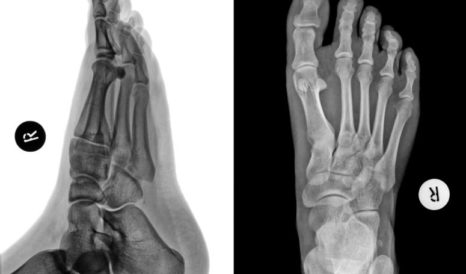Foot Injuries: When to See A Doctor
You can suffer from a foot injury in many different ways – through impact, repetitive action or sudden twisting movement. FInd out when to see a doctor here.
There are 26 bones and 33 joints in your foot, all connected with strands of fibrous tissue and muscles, and interlaced with nerves. As you can imagine, an injury to your foot can cause a complex set of problems. Ongoing foot problems can lead to ankle, knee and hip issues, as your body compensates for the imbalance in your feet.

For this reason, it’s important to understand the type of injury and to resolve it as quickly as you can.
You can injure your feet in a number of different ways – usually through impact, repetitive action or a sudden twisting movement. The small structures of your feet can get damaged easily, but in many cases, they recover quickly if you rest them. So how do you know when to see a doctor for a foot injury?
When you may need urgent care:
There are some cases where you need to see a doctor straight away – for example:
- your foot is so painful that you can’t put any weight on it
- you have an open wound that may be infected
- you suffer from diabetes
When you can use home treatment:
Mostly, if the pain isn’t too severe, you can rest your foot by elevating it as much as possible and icing it (to help reduce swelling). You can also take over-the-counter anti-inflammatories for the pain and swelling.
When to see a doctor for a foot injury:
If, after two weeks, your injured foot is still painful and swollen, or you experience tingling or numbness, you should consult a doctor.
Common foot and ankle injuries:
Many of the patients who are referred to my orthopaedic and sports medicine team suffer from the following common types of injuries:
Plantar fasciitis
The connective tissue under your foot (plantar fascia) becomes irritated and inflamed. It can cause a sharp pain or tenderness in the underside of your heel or foot arch. There may be a tingling feeling if nerves are affected. The pain is worse in the morning. This can be caused by:
- tight calf muscles
- repetitive impact (particularly running)
- ill-fitting running shoes
- flat feet
- high arches
- obesity
Treatment includes shoe inserts (orthotics) and correctly fitted running shoes. Physiotherapy can help correct your gait and stretch your calf muscles. Steroid injections may be needed to reduce the swelling. Sometimes, surgery is used to release part of the plantar fascia from its attachment at the heel bone.
Broken bones
You can fracture the bones in your foot through a sudden impact. Or you may have stress fractures – tiny cracks in the bones – which can feel painful and tender. They can be caused by:
- Runners suddenly increasing mileage
- Repetitive impact (particularly running)
- Working on hard surfaces
- High intensity twisting movements
Most fractures can be treated with rest and keeping the weight off your foot for two to three weeks or until the affected area is pain-free.
Ankle sprain
Stretched ligaments around your ankle joint can lead to pain, swelling and stiffness around your ankle. It can lead to bruising along your foot. It is caused by:
- Sharp twisting movements
- Sudden changes in direction
- Rolling your ankle (on a fall or misstep)
Treatment is usually to rest your ankle and to elevate it as much as possible for two to three weeks. For severe sprains, you may need a special boot to keep the weight off your foot. Damaged or overstretched ligaments may require surgery to tighten them.
Achilles tendonitis
The tendon that attaches your calf to your heel bone becomes swollen, causing pain in the back of your ankle and heel. It is often caused by:
- Suddenly starting or increasing intensive exercise
- Tight calf muscles
- Wearing improper footwear
- Training in cold weather
- Flat feet
- Leg length discrepancy
Treatment can include shoe inserts that lift your heel to take the pressure off the tendon and physiotherapy to help stretch your calf muscles. A tendon tear can be treated with surgery.
Morton’s Neuroma
This is caused when a lump forms around a nerve in the ball of your foot. It causes a sharp pain, like standing on a small marble. It can be the result of:
- Wearing tight shoes / high heels
- Flat feet
Treatment involves reducing the pressure on the nerve. This can involve using shoe inserts and using wider shoes. Steroids can be injected to reduce the swelling and surgery is sometimes used to cut away swollen tissue.
Simon Moyes
With early diagnosis and effective physiotherapy treatment, most foot injuries can usually be resolved easily. If surgery is necessary, many injuries can be resolved using keyhole surgery – a minimally invasive technique with short recovery time.
Simon Moyes is an internationally renowned orthopaedic surgeon and leader in the field of arthroscopic (keyhole) surgery. His Capital Orthopaedics team works from The Cromwell Hospital in London, with its state-of-the-art diagnostic and surgical equipment, and top sports medicine professionals.
